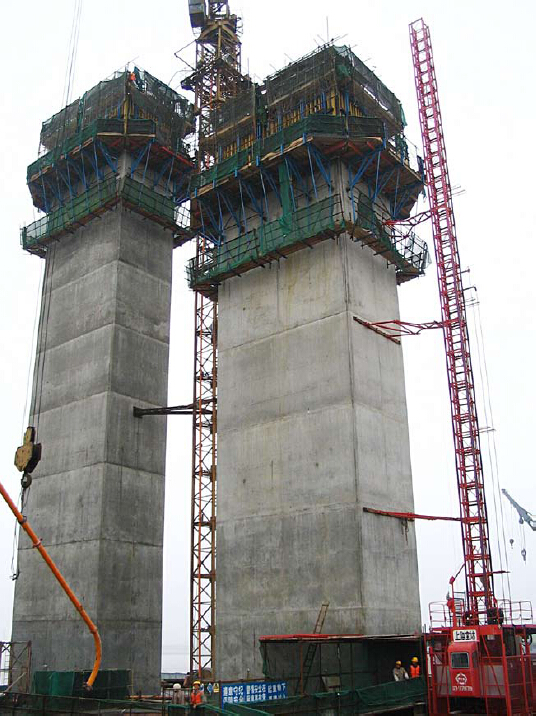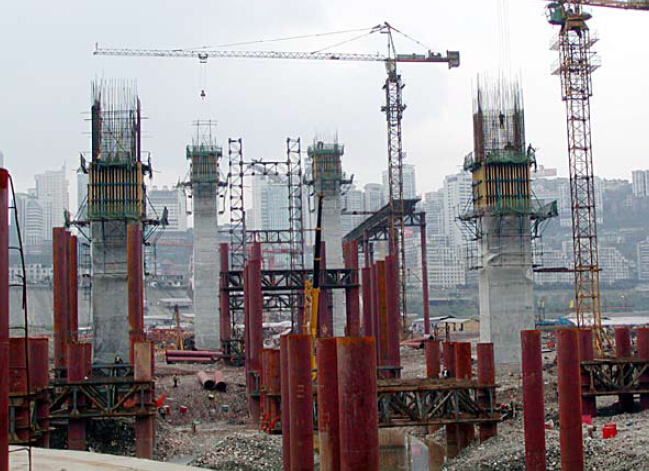Climbing Bracket CB240 & CB210 for Formwork and Scaffolding system
- Loading Port:
- Tianjin
- Payment Terms:
- TT OR LC
- Min Order Qty:
- 50 m²
- Supply Capability:
- 1000 m²/month
OKorder Service Pledge
OKorder Financial Service
You Might Also Like
Climbing Bracket CB240 & CB210
They are framework brackets for supporting large-area wall formwork.
Typical applications for the CB240&CB210 are pier and column/shear wall/core walll/ in the
building.
CB210 has smaller size than CB240, it will be cost effective in some condition.
Characteristics:
◆ High bearing capacity
The high loading capacity of the brackets allow very large scaffold units. This saves the number
anchor points required as well as reducing climbing times.
◆ Simple moving procedure by crane
Through the strong connection of formwork together with the climbing scaffold, both can be moved
as a single climbing unit by crane. Thus valuable time-savings can be achieved.
◆ Fast striking process without a crane
With the retrusive set, large formwork elements can also be retracted quickly and a minimum of
effort.
◆ Safe with work platform
The platforms have assembled firmly with bracket and will be climbing together, without scaffolding
but can work safely in spite of your high location.


- Q:How does steel formwork affect the overall safety of construction workers?
- Construction workers can greatly improve their safety by using steel formwork. The durability and strength of steel formwork make it highly resistant to damage or collapse during construction, protecting workers from potential accidents. Furthermore, steel formwork is designed to be structurally stable, providing a secure platform for workers to carry out their tasks. This stability reduces the risk of slips, trips, and falls, which are common accidents in construction sites. With a stable formwork system, workers can confidently work at heights without fear of the platform giving way. In addition, steel formwork is modular and easily assembled, allowing for quick and efficient construction processes. This reduces workers' exposure to potential hazards and risks, as they spend less time on the construction site. By shortening the project duration, steel formwork also reduces workers' fatigue and stress levels, leading to increased alertness and improved safety. Another safety advantage of steel formwork is its resistance to fire. Steel does not burn or contribute to the spread of fire, providing an extra layer of protection for construction workers in case of fire accidents on-site. This significantly reduces the risk of injuries or fatalities due to fire incidents, ensuring worker safety. Overall, the use of steel formwork in construction significantly enhances worker safety. Its durability, stability, quick assembly, and fire resistance properties all contribute to creating a safer working environment, reducing the likelihood of accidents and injuries. By investing in steel formwork, construction companies prioritize worker well-being and promote a culture of safety on the construction site.
- Q:Can steel formwork be used for both above-ground and underground structures?
- Yes, steel formwork can be used for both above-ground and underground structures. Steel formwork offers several advantages such as high strength, durability, and reusability, making it suitable for various construction applications. For above-ground structures like high-rise buildings or bridges, steel formwork provides the necessary support and stability during the casting of concrete. It can be easily assembled and disassembled, allowing for efficient construction processes. Similarly, for underground structures like tunnels or basements, steel formwork can withstand the pressures exerted by the surrounding soil and water. It helps in maintaining the required shape and dimensions of the structure until the concrete sets and gains sufficient strength. Moreover, steel formwork can resist corrosion, which is crucial for underground structures exposed to moisture and other environmental factors. Overall, steel formwork is a versatile solution that can be used effectively in both above-ground and underground construction projects.
- Q:How does steel formwork contribute to the overall sustainability of the construction industry?
- Steel formwork contributes to the overall sustainability of the construction industry in several ways. Firstly, steel formwork is highly durable and can be reused multiple times, reducing the need for new materials and minimizing waste. This not only reduces the environmental impact of construction but also lowers costs for builders. Additionally, steel formwork allows for precise and efficient construction, resulting in less material wastage and overall resource savings. Lastly, the strength and versatility of steel formwork enable the construction of more durable and long-lasting structures, reducing the need for frequent repairs or replacements, which further contributes to the sustainability of the construction industry.
- Q:Can steel formwork be used in cold weather conditions?
- Certainly! Steel formwork is applicable even in cold weather conditions. Steel, being a robust and enduring material, possesses the capability to withstand extreme temperatures. Nevertheless, it is imperative to consider the potential impact of cold weather on both the construction process and the formwork's performance. The major concern during cold weather is the potential influence of freezing temperatures on the concrete's setting and curing processes. Consequently, this can lead to construction delays and a compromise in concrete quality. To address this issue, several measures can be implemented when employing steel formwork in cold weather conditions. To begin with, it is of utmost importance to ensure that the formwork is adequately insulated to prevent heat loss and maintain the necessary temperature for the concrete. This can be accomplished by incorporating insulating materials like polystyrene or foam boards around the formwork. Furthermore, heating devices such as electric blankets or heat lamps can be utilized to sustain the desired temperature during the curing process. These devices should be strategically positioned to uniformly distribute heat without causing damage to the steel formwork. Additionally, meticulous planning of the construction schedule is crucial. This includes taking into consideration the weather forecast and avoiding concrete pouring during periods of extremely low temperatures. Techniques such as utilizing accelerators or special admixtures for cold weather concreting can also be employed to expedite the concrete's setting rate and prevent freezing. In conclusion, while steel formwork can be employed in cold weather conditions, it is essential to implement appropriate precautions to ensure the successful completion of the construction project. Adequate insulation, the utilization of heating devices, and meticulous scheduling are indispensable in mitigating the potential challenges posed by cold weather on the formwork's performance and the concrete's quality.
- Q:Is steel formwork suitable for projects with high concrete pressure?
- Indeed, steel formwork proves to be a suitable choice for projects that involve high concrete pressure. Renowned for its robustness and durability, steel formwork possesses the ability to withstand the immense pressure exerted by the wet concrete during both pouring and curing stages. It effectively bears the weight and pressure of the concrete, preventing any deformation or collapse, thus ensuring the structure's stability and integrity throughout the construction process. Furthermore, steel formwork guarantees a smooth and uniform surface finish for the concrete, which is crucial for projects that demand top-notch quality. Moreover, its reusability feature makes it a cost-effective option for projects that entail high concrete pressure.
- Q:How does steel formwork contribute to the overall sustainability credentials of the project?
- Steel formwork contributes to the overall sustainability credentials of a project in several ways. Firstly, steel is a highly durable material, which means that it can be reused multiple times, reducing the need for new materials and minimizing waste. Additionally, steel formwork allows for greater flexibility in design, enabling efficient use of materials and reducing construction time and costs. Moreover, steel is a recyclable material, so at the end of its life cycle, it can be recycled and used in other projects, further reducing environmental impact. Overall, steel formwork helps to promote sustainability by promoting resource efficiency, reducing waste, and minimizing the carbon footprint of construction projects.
- Q:Can steel formwork be easily modified or adjusted during concrete placement?
- Yes, steel formwork can be easily modified or adjusted during concrete placement. Steel is a highly flexible material that can be easily cut, welded, or reshaped to accommodate changes in design or dimensions. This allows for on-site adjustments to be made during the concrete placement process, ensuring a precise fit and desired form.
- Q:Is steel formwork suitable for projects with limited access?
- Yes, steel formwork can be suitable for projects with limited access. Steel formwork is known for its high strength and durability, allowing it to withstand the challenges of a project with limited access. It can be easily transported and assembled in confined spaces, making it a favorable choice for projects where access is restricted. Additionally, steel formwork can be easily dismantled and reused, which is beneficial in limited access situations where materials need to be transported in and out efficiently. The flexibility and adaptability of steel formwork make it a viable option for projects with restricted access.
- Q:Can steel formwork be used for precast concrete tanks?
- Certainly, precast concrete tanks can indeed utilize steel formwork. Steel, well-known for its strength, durability, and versatility, is a favored option for formwork. It supplies the essential support and structure for pouring and curing the concrete, guaranteeing the tank's desired dimensions and structural soundness. The design and fabrication of steel formwork can be tailored to meet the specific demands of precast concrete tanks, facilitating precise and efficient construction. Furthermore, steel formwork can be utilized multiple times, resulting in a cost-effective approach for producing precast concrete tanks.
- Q:What are the different safety features incorporated in steel formwork systems?
- Some common safety features incorporated in steel formwork systems include sturdy and durable construction materials, non-slip surfaces, guardrails and handrails for secure movement, proper anchoring mechanisms to prevent collapse, and clear signage to indicate potential hazards and safety precautions. Additionally, some systems may also have built-in fall protection systems or safety harness attachment points for added worker safety.
1. Manufacturer Overview |
|
|---|---|
| Location | |
| Year Established | |
| Annual Output Value | |
| Main Markets | |
| Company Certifications | |
2. Manufacturer Certificates |
|
|---|---|
| a) Certification Name | |
| Range | |
| Reference | |
| Validity Period | |
3. Manufacturer Capability |
|
|---|---|
| a)Trade Capacity | |
| Nearest Port | |
| Export Percentage | |
| No.of Employees in Trade Department | |
| Language Spoken: | |
| b)Factory Information | |
| Factory Size: | |
| No. of Production Lines | |
| Contract Manufacturing | |
| Product Price Range | |
Send your message to us
Climbing Bracket CB240 & CB210 for Formwork and Scaffolding system
- Loading Port:
- Tianjin
- Payment Terms:
- TT OR LC
- Min Order Qty:
- 50 m²
- Supply Capability:
- 1000 m²/month
OKorder Service Pledge
OKorder Financial Service
Similar products
New products
Hot products






















